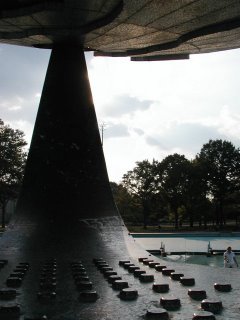John J. Neumaier

Obstacles to the abolition of war
By John J. Neumaier
07/03/06 "Information Clearing House" -- -- Some say “What a silly idea that war could ever be abolished. You can't change human nature!” But when you think about it, human nature has actually undergone significant evolutionary change. Just consider the development of language, and with it, the complexity of human communication and thought. And when it comes to resorting to war, it has become increasingly clear – at least to some observers – that it is a societal phenomenon rather than an unchangeable quality of human nature.
It’s true that violent social conflict has been around for as long as recorded history, but this doesn’t make it a law of nature. Still, many a conservative persists in invoking “human nature” to deny the very possibility of resolving societal conflicts without using permanently established armed forces. Nor is it surprising that those who benefit from militarism and the arms trade defend their deadly business in the name of patriotism, and rationalize it with the notion that warfare is part and parcel of good old “human nature”. (It was really memorable that even the World War II military leader President Dwight Eisenhower warned against the power of the “military-industrial complex”.)
At any rate, none of these claims about an unchangeable and warlike human nature invalidate the crucial point that, theoretically at least, it is not impossible for human beings to abolish war and eventually achieve permanent peace. Whether humanity will be sufficiently rational to end the recourse to war before a nuclear holocaust puts an end to civilization (or indeed to humanity itself) is another question.
This brings us to another relevant fact about socially and nationally organized violence, namely that the nature and scope of warfare has radically changed over the millennia. For example, the (now grotesque) practice of cannibalism (eating of one’s enemies’ flesh) has been almost completely overcome. However, the nuclear incineration of tens of thousands of human beings became part of twentieth century war history when President Harry Truman authorized the atomic bombing of the population of Nagasaki and of Hiroshima. Further “progress” in nuclear armaments - the horrendous and instantaneous killing, the lingering deaths and maiming of millions of human beings, probably tens of millions - evokes a terrifying possibility for future wars. Most ominous of all, the ever growing nuclear capacity of the military is now part of the weapons arsenal of many of the most powerful nation states. The government of the United States, the mightiest military power in world history, has declared its unwillingness to give up the first-strike option and is projecting a new era of weapons in space.
The daily war news from Iraq, of death and maiming of thousands of U.S. troops and of a far greater number of Iraqi civilians, and the destruction of cities are heartrending illustrations of the advanced technology of modern warfare.
Still, in spite of the ever growing inhumanity of war, people the world over tend to take the fighting of future wars for granted. All too many accept their governments’ recourse to war as “normal”, as a legitimate tool of a nation’s foreign policy. (Karl von Klausewitz famously put it “War is nothing but the continuation of politics by other means”.)
The recurrent use of war as state policy helps build its legitimacy. Since the end of World War II, the United States alone has been involved in more than a dozen wars, a fact that provides a powerful reinforcement for the view that war-making is a normal state of affairs. “We are a country at war,” intone the leaders, lending weight and a sense of inevitability to their unparalleled expansion of governmental power and secrecy, restrictions on civil liberties, and cutbacks in basic services.
Another way to win acceptance of recourse to war as being in the interest of the nation and morally justified, and indeed absolutely necessary, is for governments to subject their peoples to intense war propaganda. Ever more sophisticated psychological warfare, an integral part of modern war, is directed not only at the enemy but at the home front as well. It is an especially important propaganda device whenever a government is on the military offensive against another nation.
Although in the first World War (1914-1918), the government of Kaiser Wilhelm’s Germany was not alone in bringing the people to a nationalist fever-pitch when war was declared, its Prussian militarist tradition made it a European exemplar. The allied governments of Russia, France, England, and eventually the United States and other nations accomplished much the same. Thus, President Woodrow Wilson promoted war fever with the slogan “To make the world safe for democracy”. (Often government leaders are taken in by their own propaganda.)
While governments find it useful, even imperative, to use patriotic appeals to intensify war propaganda, they at the same time assure their people of their passionate commitment to peace. This is easier to do when a government is responding to an attack on the homeland, as when Japan attacked the U.S. navy at Pearl Harbor and the nation united behind President Franklin Roosevelt’s call to arms. Still, whatever the actual reasons for going to war, governments routinely portray their wars as defensive. And in 1949, the U..S. War Department was renamed the Department of Defense.
The war in Iraq provides a textbook illustration of how a government can engineer popular acceptance of waging war. The Bush administration succeeded (at first) in persuading a majority of Americans that the invasion of Iraq was necessary in order to prevent the brutal dictator Saddam Hussein from attacking the U.S. homeland with weapons of mass destruction. The President also claimed that this allegedly defensive war was part of the war on terrorism. In fact, however there was hostility between Osama bin Laden and Hussein, and no evidence of Al Qaeda having a stronghold in Iraq, at least not before the war. Of course, the U.S. public was kept in the dark regarding the true state of affairs. Then, as now, there is official silence about how the U.S. government for years strongly supported Saddam Hussein (especially during his Iraq war against Iran) in spite of the dictator’s well-known violence against his own people.
If we are concerned about the role of war in history, and more importantly, with its significance for humanity’s future, all of us need to think long and hard about it. We need to learn about and discuss its many aspects: the causes, the atrocities and the mass suffering it brings, the huge costs of war and preparation for war, the various forms and examples of war propaganda, terrorism and its background, the laws of war, including the Geneva Conventions and their violations, the issue of just or necessary wars, and especially the cause of peace, and humankind’s prospects for some day abolishing war altogether. Most of all we need to join in common actions in behalf of peace and social justice, here and abroad.
Poughkeepsie resident Dr. John J. Neumaier was president of SUNY New Paltz from 1968-72 and of Moorhead (Minn.) State University from 1958-68. He is philosophy professor emeritus of Empire State College, New York City. His column appears in the first Sunday Freeman of each month."
JOHN NEUMAIER
Dr. John Neumaier, the seventh president of the college, was born Hans Neumaier in Frankfurt-am-Main, Germany, the son of a prominent businessman and a famous opera star. Forced to leave Germany as a young man during the Nazi persecution of German Jews, young Neumaier came to the United States in 1940, changing his name to John. He was educated at the University of Minnesota, and taught philosophy at Hibbing College before becoming dean of the college in 1955. Dr. Neumaier became president of Moorhead State College in 1958 and served here until 1968, presiding over one the most dynamic eras of the school. He subsequently served as president of the College of New Paltz in New York, retiring in 1972.











